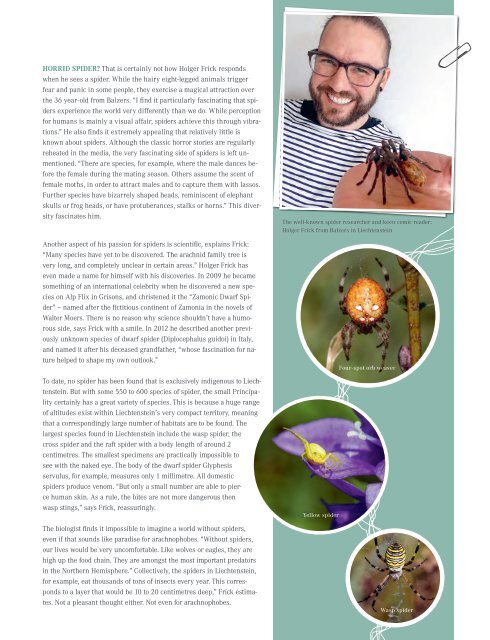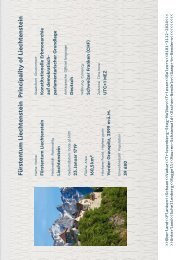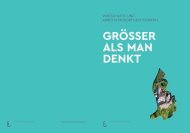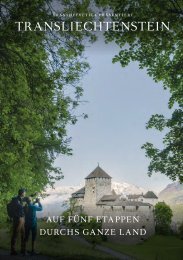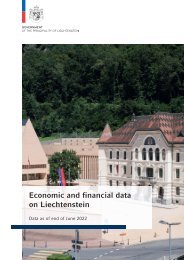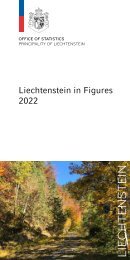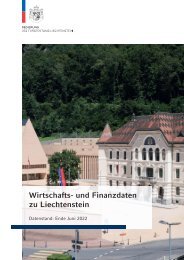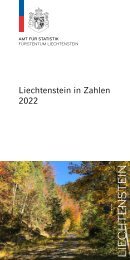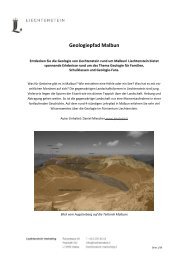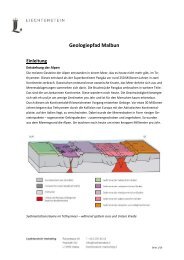oho #3 - The magazine of the Principality of Liechtenstein
The Liechtenstein magazine takes you onto a journey through the country. Find out more about the state, the Princely House, the nature, the culture, the economy and more.
The Liechtenstein magazine takes you onto a journey through the country. Find out more about the state, the Princely House, the nature, the culture, the economy and more.
Create successful ePaper yourself
Turn your PDF publications into a flip-book with our unique Google optimized e-Paper software.
HORRID SPIDER? That is certainly not how Holger Frick responds<br />
when he sees a spider. While <strong>the</strong> hairy eight-legged animals trigger<br />
fear and panic in some people, <strong>the</strong>y exercise a magical attraction over<br />
<strong>the</strong> 36 year-old from Balzers. “I find it particularly fascinating that spiders<br />
experience <strong>the</strong> world very differently than we do. While perception<br />
for humans is mainly a visual affair, spiders achieve this through vibrations.”<br />
He also finds it extremely appealing that relatively little is<br />
known about spiders. Although <strong>the</strong> classic horror stories are regularly<br />
reheated in <strong>the</strong> media, <strong>the</strong> very fascinating side <strong>of</strong> spiders is left unmentioned.<br />
“<strong>The</strong>re are species, for example, where <strong>the</strong> male dances before<br />
<strong>the</strong> female during <strong>the</strong> mating season. O<strong>the</strong>rs assume <strong>the</strong> scent <strong>of</strong><br />
female moths, in order to attract males and to capture <strong>the</strong>m with lassos.<br />
Fur<strong>the</strong>r species have bizarrely shaped heads, reminiscent <strong>of</strong> elephant<br />
skulls or frog heads, or have protuberances, stalks or horns.” This diversity<br />
fascinates him.<br />
Ano<strong>the</strong>r aspect <strong>of</strong> his passion for spiders is scientific, explains Frick:<br />
“Many species have yet to be discovered. <strong>The</strong> arachnid family tree is<br />
very long, and completely unclear in certain areas.” Holger Frick has<br />
even made a name for himself with his discoveries. In 2009 he became<br />
something <strong>of</strong> an international celebrity when he discovered a new species<br />
on Alp Flix in Grisons, and christened it <strong>the</strong> “Zamonic Dwarf Spider”<br />
– named after <strong>the</strong> fictitious continent <strong>of</strong> Zamonia in <strong>the</strong> novels <strong>of</strong><br />
Walter Moers. <strong>The</strong>re is no reason why science shouldn’t have a humorous<br />
side, says Frick with a smile. In 2012 he described ano<strong>the</strong>r previously<br />
unknown species <strong>of</strong> dwarf spider (Diplocephalus guidoi) in Italy,<br />
and named it after his deceased grandfa<strong>the</strong>r, “whose fascination for nature<br />
helped to shape my own outlook.”<br />
To date, no spider has been found that is exclusively indigenous to <strong>Liechtenstein</strong>.<br />
But with some 550 to 600 species <strong>of</strong> spider, <strong>the</strong> small <strong>Principality</strong><br />
certainly has a great variety <strong>of</strong> species. This is because a huge range<br />
<strong>of</strong> altitudes exist within <strong>Liechtenstein</strong>’s very compact territory, meaning<br />
that a correspondingly large number <strong>of</strong> habitats are to be found. <strong>The</strong><br />
largest species found in <strong>Liechtenstein</strong> include <strong>the</strong> wasp spider, <strong>the</strong><br />
cross spider and <strong>the</strong> raft spider with a body length <strong>of</strong> around 2<br />
centimetres. <strong>The</strong> smallest specimens are practically impossible to<br />
see with <strong>the</strong> naked eye. <strong>The</strong> body <strong>of</strong> <strong>the</strong> dwarf spider Glyphesis<br />
servulus, for example, measures only 1 millimetre. All domestic<br />
spiders produce venom. “But only a small number are able to pierce<br />
human skin. As a rule, <strong>the</strong> bites are not more dangerous <strong>the</strong>n<br />
wasp stings,” says Frick, reassuringly.<br />
<strong>The</strong> biologist finds it impossible to imagine a world without spiders,<br />
even if that sounds like paradise for arachnophobes. “Without spiders,<br />
our lives would be very uncomfortable. Like wolves or eagles, <strong>the</strong>y are<br />
high up <strong>the</strong> food chain. <strong>The</strong>y are amongst <strong>the</strong> most important predators<br />
in <strong>the</strong> Nor<strong>the</strong>rn Hemisphere.” Collectively, <strong>the</strong> spiders in <strong>Liechtenstein</strong>,<br />
for example, eat thousands <strong>of</strong> tons <strong>of</strong> insects every year. This corresponds<br />
to a layer that would be 10 to 20 centimetres deep,” Frick estimates.<br />
Not a pleasant thought ei<strong>the</strong>r. Not even for arachnophobes.<br />
<strong>The</strong> well-known spider researcher and keen comic reader:<br />
Holger Frick from Balzers in <strong>Liechtenstein</strong><br />
Yellow spider<br />
Four-spot orb weaver<br />
Wasp spider<br />
Bild: Jean-Jacques Ruchti<br />
63


